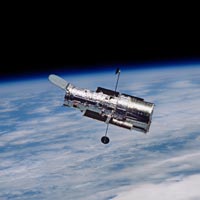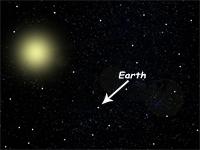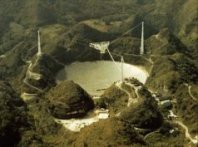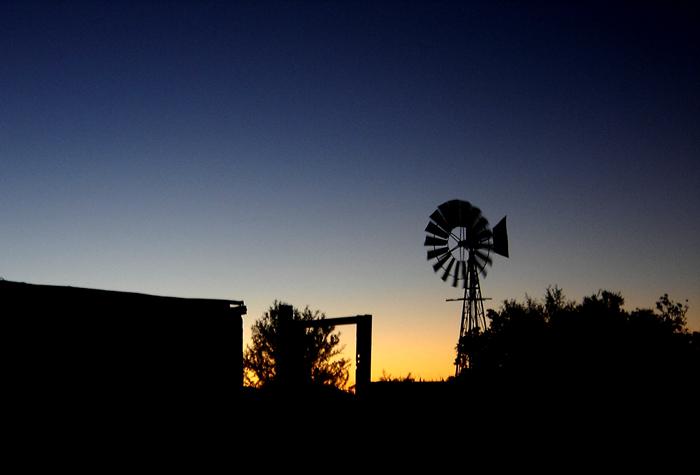|
SpaceTides e-zine
#49 – November 2006
Internet
Newsletter of ASSA Bloemfontein Centre, South
Africa, to the public
www.assabfn.co.za/spacetides

|
Subscribe to the free SpaceTides e-zine by
sending an e-mail to spacetides@assabfn.co.za
with the word "Subscribe" in the subject line if you are not
already subscribed. |
In this issue of SpaceTides |
INDEX
1. Spaceflight
news from around the world
- Hubble
servicing mission announced
2. Astronomy
news from around the world
- HESS in Namibia detects gamma rays streaming from vicinity
of black holes
- Thriving bacteria found 3 kilometers under Earth's
surface
3. Interesting
space facts: Gas Pillars in M16, the Eagle Nebula
4. The
Solar System: Our Living World, Earth
5. Sky
Observation log: November 2006 skies
6. Amateur
Astronomers' Corner: Announcing ASSA's Top 100 Deep Sky list
7. Observatories
of the World: Arecibo Radio Telescope
8. Astronomy
in Southern Africa: South African Astronomical Observatory (SAAO - Cape Town)
9. Photo
Sense
10. Web
links
_________________________________________________________________________________________
Dear
SpaceTides Subscribers
The year is fast approaching its end and it is usually around this time of
the year that one realizes how much there still is to do! At least we can
look forward to the holidays.
NASA decided to service Hubble again! Previously, due to various reasons,
such a mission was in the balance.
Remember to have a look at Mercury and Jupiter at the start of November,
lying just above the western horizon during sunset. A MUST see!
For those interested in Deep Sky Observations: ASSA has compiled a
stunning list of the 100 best objects in our skies. If you have a
binocular or telescope, go out and have a look with references to this list.
Stuck in the city? Then at least observe those that you actually CAN see from
your backyard! Light pollution is no excuse for the brighter objects if you
simply cannot go outside the city - you'll be surprised at how many you can
still see (except if you live underneath some stadium lights that is...)
Please see section
6 below.
Have you considered subscribing to Scientific American yet? I've done
so recently ($44 a year for 12 issues) and I think it is definitely worth the
money. Informative and comprehensive science articles. Visit their site at www.sciam.com.
Enjoy this month's SpaceTides! Next issue will be the 50th edition - stay
tuned for some prizes and giveaways...
Gerrit Penning, editor
Bloemfontein, South Africa
Total subscribers as at 1 November 2006: 713 (+26 from previous
issue #48) |
1. Spaceflight news from around the world |

The HST in
orbit above Earth. NASA.
|
Service
mission to the HST announced
Extracts from a NASA press
release dated 31 October 2006. Read full
article.
Good news for science. Shuttle astronauts will make one final house
call to NASA's Hubble Space Telescope as part of a mission to extend and
improve the observatory's capabilities through 2013. The flight is
tentatively targeted for launch sometime during 2008.
Two new instruments will also be fitted. They are the Cosmic Origins
Spectrograph (COS) and Wide Field Camera 3 (WFC3). The COS will be the most
sensitive ultraviolet spectrograph ever flown on Hubble. The instrument will
probe the cosmic web, the large-scale structure of the universe whose form is
determined by the gravity of dark matter and is traced by the spatial
distribution of galaxies and intergalactic gas. WFC3 is a new camera
sensitive across a wide range of wavelengths. Other planned work includes
installing a refurbished Fine Guidance Sensor which controls the telescope's
pointing system. An attempt will also be made to repair the Space Telescope
Imaging Spectrograph which stopped working in 2004. NASA
HST: www.nasa.gov/mission_pages/hubble/main/index.html |
________________________________________________________________________________________
2. Astronomy news from around the world |

|
HESS
in Namibia detects gamma rays streaming from vicinity of black holes
Max Planck Society news release, Oct 26, 2006
An international team of astrophysicists using the H.E.S.S.
telescope in Namibia has announced the detection of short-term changes in
the energy flow of gamma rays from radio galaxy M 87. They've observed
the object over the past 4 years, but surprisingly, have noted that the
intensity of the emission can be seen to change drastically within a few days
on occasion.
The image at far left shows M 87 seen at very high energies
and the right image shows the galaxy at (low) radio wave lengths. Read full
article. |
________________________________________________________________________________________

|
Thriving
bacteria found 3 kilometers under Earth's surface
Princeton University news release, October 20, 2006. Full
article.
Extreme living. A Princeton-led research group has discovered an
isolated community of bacteria nearly 3 km underground that derives
all of its energy from the decay of radioactive rocks rather than from
sunlight. The finding suggests life might exist in similarly extreme
conditions even on other worlds or even on other planets and moons in our
solar system. The self-sustaining bacterial community, which thrives in
nutrient-rich groundwater found near a South African gold mine, has
been isolated from the Earth's surface for several million years. It
represents the first group of microbes known to depend exclusively on
geologically produced hydrogen and sulfur compounds for nourishment. The
extreme conditions under which the bacteria live bear a resemblance to those
of early Earth, potentially offering insights into the nature of organisms
that lived long before our planet had an oxygen atmosphere. |
________________________________________________________________________________________
3. Interesting Space Facts |

Hubble photo
of a gas pillar in M16 NASA, ESA, STScI/AURA
|
Gas Pillars in Space
The Hubble photo
at left shows a detailed view of the Eagle Nebula (M16), which is just a
small portion of a pillar of gas and dust some 9.5 light years high. Light
shining from nearby bright, hot, young stars is busy arranging the cloud into
strange intricate forms and causing the gas to glow. If it wasn't for these
stars, we would not have been able to see the gas.
Stars in the Eagle Nebula are born in clouds of cold hydrogen gas that reside
in chaotic neighborhoods, where energy from young stars sculpts fantasy-like
landscapes in the gas. The tower may be a giant "incubator" for
those newborn stars. A torrent of ultraviolet light from a band of these
young stars is eroding the pillar.
>From HubbleSite.org. More info and high-resolution images: http://hubblesite.org/newscenter/archive/releases/2005/12/image/e |
4. The Solar System: Earth |

|
Earth:
the Living World
The planet Earth: a small blue dot in a vast ocean of nothingness. Watery
blue expanses and twirling white clouds gliding through the atmosphere. Vast
continents of land and ice rising into the sky. And on its surface; an
abundance of life-forms, some so complicated and mysterious that it seems to
defy all probabilities. Our planet appears unique in many aspects. Water
covers 70% of its surface and remarkably, 21% of its atmosphere consists of
oxygen. Geological activity occurs, but the planet is still stable
enough to provide conditions for life. Weather patterns maintain an
active climate, while the 23.5° tilt of the planet’s axis results in
seasons. Everyone who ever lived, every politician, sport star,
dictator, loving couple, teacher and child, have spent their lives on this
tiny piece of rock. It's the only rock we have: shall we protect it for
future generations, or rather make our problems theirs? |
his was the 4th part in a 12-part series about the Solar
System.

|
Planets
- November
2006
Mercury: At the star
of the month, Mercury pairs up with Jupiter in the western sky slightly above
the horizon, visible just after sunset. It is a morning object from
mid-month.
Venus and Mars are both too close to the Sun for observation. Earth will
appear just below your horizon, in a 360 degree all-round view. Best
visibility occurs in daytime.
Jupiter is visible slightly above the horizon in the west during sunset,
Jupiter being the brighter planet to the right of Mercury. The beginning of
November is THE TIME to look at the pair! Saturn can be seen in the
morning sky.
Constellations - November 2006
Andromeda is
just above the northern horizon: now is the time to look at the Andromeda
galaxy (even visible with the naked eyes). Pegasus (the Flying Horse) is in
full view above Andromeda in all its splendour. Trailing it is Aries (the
Ram) and Triangulum to the east. "Above" Pegasus you will find
Pisces, the northern Fish. Further up and you arrive at Aquarius (to the
west) and Cetus the Whale (to the east) - can you see the variable star Mira?
On your zenith is the star Fomalhaut in the Southern Fish. The second
brightest star visible from Earth, Canopus, is rising in the south-east.
Have a look towards the south and you might spot the Small and Large
Magellanic clouds, satellite galaxies of our own Milky Way galaxy.
Other night sky
events - November 2006
Leonid meteor shower predicted for possible peak on November 19, observations favourable due to
dark moon. Best times between 17 and 21 November, 1h00 to 3h30 in the
morning.
Full Moon on 5 November 2006.
New Moon on 21 November 2006.
Comet Swan visible in the evenings early November in Hercules. Charts
on heavens-above.com. Although it
might be visible with the naked eye, have a binocular handy to search for it.
If you see it, let ASSA Bloemfontein know please!
Spica gets occulted by the Moon on 18 November - see Sky Guide 2006
for details.
Image to left: (Stellarium) The western horizon
early November: a beautiful sight indeed! |
6. Amateur Astronomers' Corner |

Take the time you need and work through 100 of the best objects.
|
Announcing
ASSA's Top 100 Deep Sky Objects
For those of you interested in observing the night sky with a binocular or
telescope should strongly consider looking at the objects in the ASSA Deep
Sky section's Top 100 Deepsky list. It equates to less than 10 objects a
month. ASSA Centres are encouraged to use this list and bring it under the
attention of their members.
So, you have a binocular or telescope, but you don't know where to begin or
it's been a long time since you've gone outside? Here's your answer! A list
of the best objects in the southern skies. If this doesn't satisfy you,
nothing will... (and it's free by the way, can you believe). The motivation
you've been waiting for. There's even prizes to be won in a competition.
Observers who have experience in deepsky should take note that national
observer certificates and awards will be given to those completing even parts
of the list. The Deep Sky section of ASSA is managed by its Director, Auke
Slotegraaf, who compiled the list with the assistance of Magda Streicher,
also of ASSA. Go to the Pscychohistorian's
site for download. |
7. Observatories of the World |

The Arecibo Radio Telescope |
Arecibo Radio Observatory
The Arecibo Radio Telescope
was commissioned in 1963 and is located 16 km south of the town of Arecibo in
Puerto Rico. It is the world's largest (305 m) single dish radio telescope
and has a spherical reflector dish consisting of perforated aluminum panels
that focus incoming radio waves on movable antenna structures positioned
about 150 m above the reflector dish. The observatory made numerous
contributions to astronomical research, for example the detection of neutron
star matter in pulsars.
The telescope has also been used in the Search for Extraterrestrial
Intelligence (SETI) where scientists either sent out signals to other stars,
or analyzed incoming signals they believe might have been sent by alien
races. The telescope has also been used as the setting for a few movie
films. Arecibo homepage: http://www.naic.edu/ |
8. Astronomy in Southern Africa |

|
South
African Astronomical Observatory: Cape Town Headquarters
The SAAO is
headquartered in the suburb of Observatory in Cape Town. Its history dates
back to 1828 when it was designed to house the main
instruments and to provide accommodation for the Astronomer Royal at the Cape
and his assistants. Today the building contains various facilities, as well
as a library and provides office space for the staff. The library
contains an outstanding collection of books and journals. There are various
telescopes on the premises, which include:
- 6 inch visual refractor (erected 1882).
- 16 inch: Parks 1994 f/5 telescope.
- 18 inch: Dall-Kirkham reflector (1955) on mount by Repsold (1887) f/11.
- 24 inch: McClean refractor. Grubb, 1897.
(Note that SAAO's research instruments are locted at Sutherland in the
Northern Cape) Website: www.saao.ac.za
|
_________________________________________________________________________________________
Regulars:
__________________________________________________________________________________________
thenewRadiant
A
community of amateur astronomers on the web - join astronomy enthusiasts from
all over the world in
this SA-operated astronomy forum. http://www.thenewradiant.com/
__________________________________________________________________________________________
November
Skies and Podcast
A
detailed look at what's up in the sky in November 2006: psychohistorian.org.
__________________________________________________________________________________________
ASSA
national web news update
Subscribe
to the free ASSA web
update service. You receive a monthly email with links to news and
events in Southern African astronomy.

On 21 October 2006, a few
of the members of ASSA Bloemfontein Centre set up telescopes on a farm near
Koffiefontein (thank you Georgie & Marthinus van der Walt for all the
hospitality!), under exquisite dark and clear skies. It was astonishing to
see galaxies such as NGC 55, NGC 253 and M31 (Andromeda galaxy) in such stark
detail. We were almost inclined to call the bright Small and Large Magellanic
clouds light pollution! Photo by Gerrit Penning during sunset on the farm.
|
|



